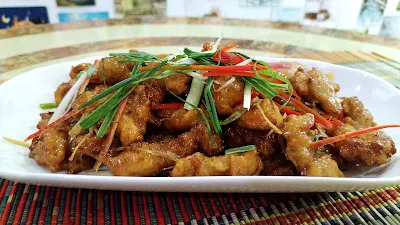Crispy Sweet and Sour Pork "Guo Bao Rou"(锅包肉)
Do you know about, or have you ever
tried "Guo Bao Rou"(锅包肉)? It is originated in Harbin, China.
The primary ingredient is pork, but
halal restaurants substitute beef for pork.
The cooking method of "Guo Ba
Rou" is extremely like Cantonese cuisine, sweet and sour pork. Both are sweet
and sour delicacies. These two dishes nevertheless differ from one another in
some way. What makes the approach
different?
Both recipes use pork tenderloin.
Sweet and sour pork is made by cutting the pork into strips and coating it with
flour or starch, deep fried till golden.
Guo Bao Rou is made by cutting the pork tenderloin into thin slices, coated with batter and frying it until it is golden in colour.
The sweet and sour pork is coated
with thick sauce which is made with white vinegar, sugar, and tangy tomato
ketchup, garnished with pineapple and bell peppers. Guo Bao Rou does not have
any extra sauce, but before adding the white vinegar and sugar-based sauce,
shredded spring onion and ginger must be sauteed until aromatic. The fried pork
was thinly coated with the sauce, garnished with coriander, and shredded carrot
or chilies.
The types of flour used to fry pork
for both recipes are different as well. Sweet and sour pork was coated with
corn flour or tapioca starch. Guo Bao
Rou used potato starch to make the batter. This is the reason why Guo Bao Rou
has a crispy texture compared to sweet and sour pork.
To make a perfect batter, my advice is
to hold back a little of the water from the recipe, and adding it in
incrementally, going by feel rather than measurement, is the preferred way to
get a perfect batter. If the batter is too thin, it will run off easily, and the
fried meat will be dry and hard; if the paste is too dry, the batter will be
too thick, and the fried meat will be too thick, which will affect the taste.
Another crucial step is the pork
slices must be fried twice. The secret to extremely crispy pork slices is
double frying. That evaporation process is helped by double frying. Additional
water evaporates from the pork by allowing it to cool and rest in between
dipping it in the oil. The remaining water evaporates as you put it back in the
second time, allowing the pork slices to crisp and brown before they overcook.
Let us get all the ingredients to
hand to make this tasty Gou Bao Rou.
INREDIENTS
400g pork tenderloin
200g potato starch
150ml water
2 tsp cooking oil
2 tsp light soy sauce
1 tsp Shaoxing wine
¼ tsp black pepper
1 stalk of spring onion (white part),
hand julienned
1 stalk of spring onion (green part),
hand julienned
15g ginger, hand julienned
1 red chili, hand julienned
4 cloves garlic, sliced
Some cooking oil (for frying)
SAUCE
2 tbsp vinegar
3 tbsp sugar
¼ tsp salt
1 tsp light soy sauce
METHODS
1. Cut the tenderloin into thin
slices and put it into a bowl. Add in the light soy sauce, Shaoxing wine and
pepper to the pork, marinate for 30 minutes.
2. Combine all the sauce ingredients
in a bowl, taste and adjust, set aside.
3. Combine the potato starch and
water in a bowl. Add 2 tsp of cooking oil to the batter, so that the fried meat
slices will be crispier. Add in the marinated
pork slices into the batter and mix well until all pork slices are well coated
with the batter.
5. In a deep bottom wok, heat up the oil, carefully add the coated pork slices to the heated oil. To prevent the pan from being overcrowded, keep the pork slices equally spaced out. Fry them in hot oil until golden brown. Remove the deep-fried pork slices. Wait until the oil reaches the proper temperature. Continue with the following batch. Once all the meat slices has been fried, wait until the oil reaches the right temperature once more before placing the meat slices back in for an additional one to two minutes of double frying. This will aid in producing an extremely crispy and golden outside.
6. Add a little oil to the wok, heat
up at high heat, sauté the shredded spring onion, ginger, and garlic until aromatic,
then pour in the sauce, stir well until the sauce is bubbling.
7. Pour the fried meat slices in and
stir-fry rapidly to coat them equally in sauce. It shouldn’t take too long to
fry the meat. At this time, a large
amount of white vinegar volatilizes, which may be a little choking. Serve it
when it is still warm. ENJOY!!





Comments
Post a Comment